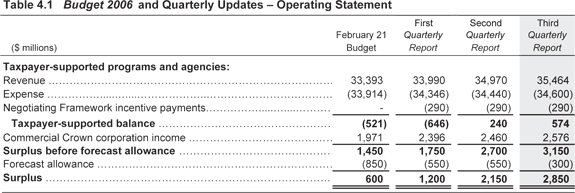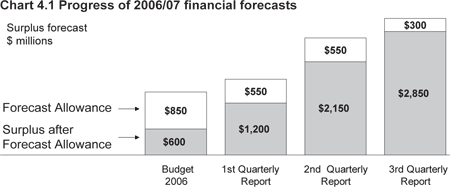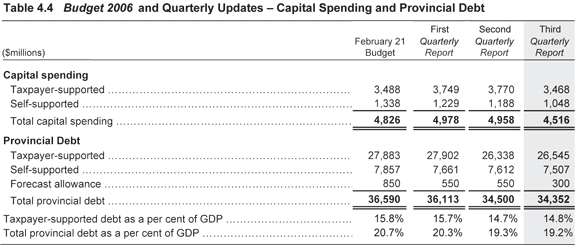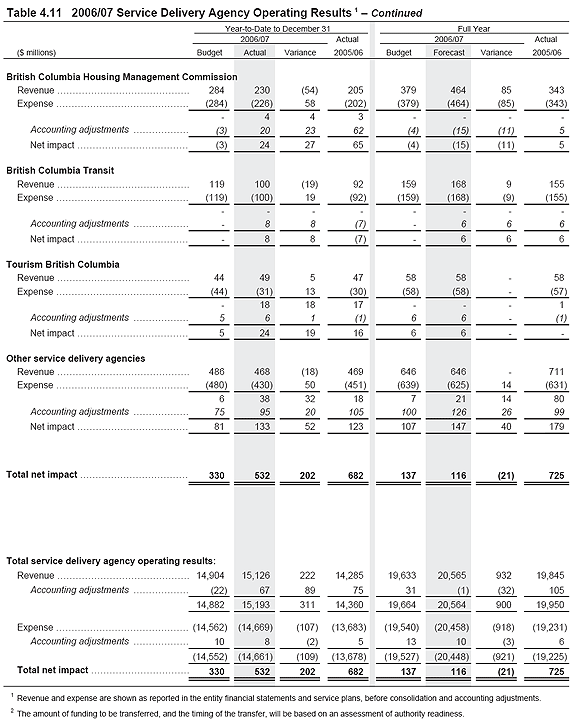Part 4: 2006/07 Updated Financial Forecast
(Third Quarterly Report)

2006/07 Fiscal Year in Review
The government's surplus for 2006/07 is projected at $2.85 billion, $2.25 billion higher than the Budget 2006 budget.
Government revenue is forecast to be $2.7 billion higher than the projection in Budget 2006, reflecting one-time revenues of $793 million ($385 million from prior year tax results and $408 million from federal trust
funds), $1.3 billion in other taxpayer supported revenues (mainly from taxation), and a $605 million increase in income from
commercial Crown corporations.
Increased revenue is partially offset by higher than expected expenses ($976 million higher than Budget 2006), reflecting forest fire costs, negotiating framework incentive payments, spending on one-time projects funded by the federal
government and increased spending by service delivery agencies.
The 2006/07 forecast allowance is now $300 million, reflecting reduced forecast risk over the remaining three months of the
fiscal year. Further details on the changes from Budget 2007 are provided in Table 4.7.

Changes since the Second Quarterly Report
The surplus forecast for 2006/07 has improved by $700 million from the second Quarterly Report forecast, mainly due to higher personal income tax revenue, increased income from commercial Crown corporations, and the
reduction in the forecast allowance.

Since the second Quarterly Report in November:
- The forecast for total revenue, including income from commercial Crown corporations, increased $610 million.
- Taxpayer-supported revenue is up $494 million, primarily due to higher personal income tax revenue due to stronger estimates
for 2006, increased investment income from larger investment balances, natural gas royalties resulting from higher prices,
and forest revenue from logging tax on duty deposit refunds.
- Income from commercial Crown corporations increased by $116 million, primarily due to the impact of increased casino revenue
on BCLC's net income and lower claims cost projections on ICBC's bottom line.
- Total spending increased $160 million from the previous forecast, primarily due to increased spending on one-time programs
partially funded by the federal government.
- Spending on one-time programs, whose costs are recoverable from the federal government and other sources, increased by $248 million. These programs include Mountain Pine Beetle mitigation, housing projects, and transportation capital projects.
- The additional spending on one-time programs was partially offset by $88 million in lower expenses in other areas, primarily
due to a reduction in net spending by service delivery agencies.
- The forecast allowance was reduced by $250 million in recognition of lower uncertainties remaining until the accounts for
the full year are completed.
Table 4.2 provides more details on developments since the second Quarterly Report.

2006/07 Priority Ministry Spending
As a result of ministry year-end savings, the province has an opportunity to fund or accelerate the following priority initiatives
in 2006/07:
- $20 million for LocalMotion, to be invested in bike paths, walkways, greenways and accessibility improvements for persons with disabilities. The Ministry
of Economic Development will fund $13 million of this initiative from internal savings and $7 million will be funded from
the Contingencies vote.
- $5 million for forest service road and bridge maintenance, and the replacement of the Farwell Canyon Bridge.
2006/07 Notional Contingencies Allocations
Spending commitments and pressures totaling $267 million have been notionally allocated to the Contingencies vote. These allocations
include:
- As in the second Quarterly Report, up to $86 million for recently negotiated K–12 service improvements and $37 million to address recommendations from the October
2005 Ready Report;
- $38 million for supportive housing projects;
- $30 million to fulfill government's commitment towards First Nation's economic development and conservation management initiatives
within the central coast, north coast and Queen Charlotte Islands areas. The federal government has committed to contribute
$30 million and private contributors are also expected to partner, resulting in a total combined investment of $120 million
for these initiatives;
- As in the second Quarterly Report, $20 million relating to negotiating framework costs above the estimated $420 million allocation for 2006/07 (resulting from
re-profiling the $4.7 billion negotiating framework's estimated annual costs to match the contract settlement requirements);
- $20 million to provide scholarships and internships to support new and existing graduate spaces; and
- $12 million for a provincial contribution to complete the implementation of PRIME (Police Records Information Management
Environment).
See Table 4.3 for a complete list of notional Contingencies vote allocations.

Capital Spending and Provincial Debt
Updated capital spending of $4.5 billion is $442 million lower than the second Quarterly Report forecast and $310 million lower than the Budget 2006 amount. The change from the second Quarterly Report is mainly due to slower than expected spending on post-secondary education and health facilities and electricity distribution
projects, lower spending for gaming equipment, and a lower contingency for capital spending.

Significant changes since the second Quarterly Report are shown in Table 4.5. Further details on capital spending are shown in Table 4.12. Information on updated forecasts for
major capital projects (those with multi-year budgets totaling $50 million or more) is provided in Table 4.13.
Provincial debt is forecast to total $34.4 billion at year-end ($2.2 billion below the Budget 2006 amount), while taxpayer-supported debt is expected to total $26.5 billion ($1.3 billion below budget).
The total debt forecast is $148 million lower than forecast in the second Quarterly Report mainly due to lower capital spending for post-secondary education and health facilities, and power generation projects, and
a reduced forecast allowance, partially offset by the Housing Endowment Fund investments and higher working capital requirements
for government operating purposes (see Table 4.5).
Total debt represents 19.2 per cent of provincial GDP, while taxpayer-supported debt is to 14.8 per cent of GDP. The debt
to GDP ratios forecast in the Budget 2006 for total and taxpayer-supported debt were 20.7 per cent and 15.8 per cent respectively. The improvements in the debt to
GDP ratios reflect lower than expected debt balances and stronger than forecast GDP.
Further information on the debt forecast is shown in Table 4.14.











